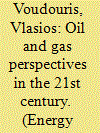| Srl | Item |
| 1 |
ID:
126803


|
|
|
|
|
| Publication |
2014.
|
| Summary/Abstract |
European energy and climate change policy rests on two main pillars: the internal energy market (IEM), and the climate change package (CCP). The IEM aimed at third party access and unbundling, neglecting the physical infrastructure and the basis for asset valuations and hence the harmonisation of network charges. The Commission plans to complete the IEM by 2014-almost a quarter of a century after embarking on the policy. Yet even if all the IEM directives are implemented, the EU will remain far from a single competitive market. The CCP was grounded on short term targets (the 2020-20-20 programme) on the assumption that fossil fuel prices would rise, making renewables competitive, and hence yielding a competitive advantage to the EU. The EUETS was intended to lead the way to a global trading system and an international agreement at Copenhagen. The EU has reduced the production of carbon emissions, but only as a result of de-industrialisation and slow growth, and at the expense of rising carbon consumption. Renewables have not led to green growth, but rather to a further eroding of competitiveness. The EUETS price has collapsed. In order for the EU to put the IEM and the CCP back on track, both need to be radically reconsidered. The IEM requires a refocusing on physical infrastructure, common accounting rules and an EU-wide approach to capacity markets and renewables trading. The CCP requires a refocusing on carbon consumption, on limiting the dash-for-coal, and on future rather than current renewables.
|
|
|
|
|
|
|
|
|
|
|
|
|
|
|
|
| 2 |
ID:
126799


|
|
|
|
|
| Publication |
2014.
|
| Summary/Abstract |
Forty years ago, the world experienced the "first oil shock". Back then the world had just ended a period of strong economic growth in the developed world, with rising US oil imports, and began a period of turbulence in the price of oil and for many national economies. Back then (as now) it was recognised that oil price rises might snuff out economic recovery. Drawing on the names of the scenarios which Shell's planners introduced at that time, we were passing through "The Rapids" and about to enter a "World of Internal Contradictions", in recent years there have again been many indicators of a "World of Internal Contradictions". and with the financial crisis and turbulence in oil markets those of "The Rapids" too. This issue is therefore timely, as many of those earlier challenges are still with us.
|
|
|
|
|
|
|
|
|
|
|
|
|
|
|
|